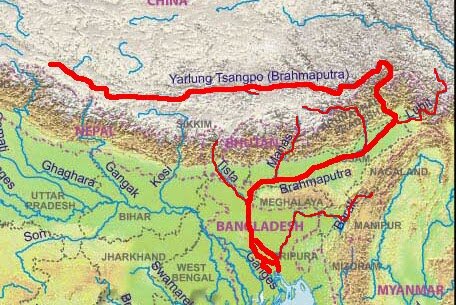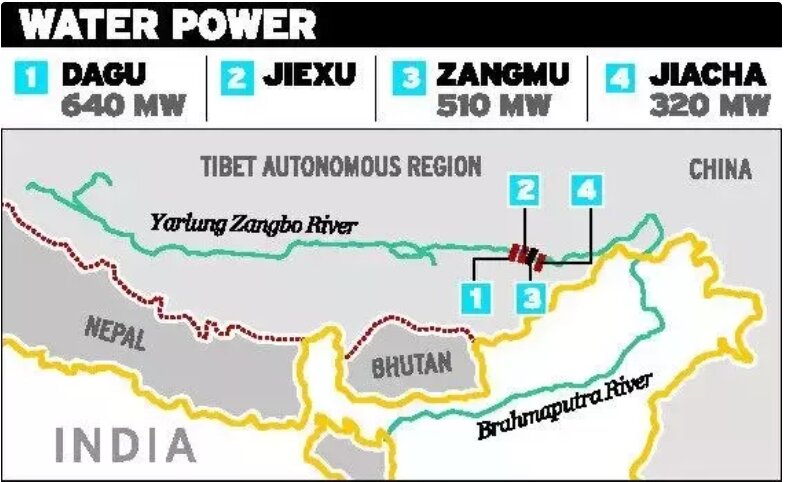International Relations
China’s New Dam on Brahmaputra
- 30 Nov 2020
- 5 min read
Why in News
Recently, Chinese authorities have given the go ahead for a Chinese hydropower company to construct the first downstream hydropower project on the lower reaches of the river Brahmaputra (known as Yarlung Zangbo in Tibet).
Key Points
- Brahmaputra:
- It originates under the name of Siang or Dihang, from the Chemayungdung glacier of the Kailash range near the Mansarovar lake. It enters India west of Sadiya town in Arunachal Pradesh.
- Tributaries: Dibang, Lohit, Siang, Burhi Dihing, Tista, and Dhansari.
- It is a perennial river and has several peculiar characteristics due to its geography and prevailing climatic conditions.
- It is flooded twice annually. One flood is caused by the melting of the Himalayan snow in summer and the other due to the monsoon flows.
- The frequency of these floods have increased and are devastating due to climate change and its impact on high and low flows.
- These pose a concern for the population and food security in the lower riparian states of India and Bangladesh.
- The river is in itself dynamic as frequent landslides and geological activity force it to change course very often.
- It originates under the name of Siang or Dihang, from the Chemayungdung glacier of the Kailash range near the Mansarovar lake. It enters India west of Sadiya town in Arunachal Pradesh.
- About the Project:
- The state-owned hydropower company POWERCHINA signed a strategic cooperation agreement with the Tibet Autonomous Region (TAR) government to implement hydropower exploitation in the downstream of the Yarlung Zangbo river as part of the new Five Year Plan (2021-2025).
- This will be the first time the downstream sections of the river will be tapped. However, the location of the planned project has not been mentioned anywhere.
- The Great Bend of the Brahmaputra and the Yarlung Zangbo Grand Canyon in Medog county, where the river turns sharply to flow across the border into f Arunachal Pradesh could be the potential spot for the project.
- This 50 km section alone offers a potential of developing 70 million kilowatt hours (Kwh).
- The state-owned hydropower company POWERCHINA signed a strategic cooperation agreement with the Tibet Autonomous Region (TAR) government to implement hydropower exploitation in the downstream of the Yarlung Zangbo river as part of the new Five Year Plan (2021-2025).
- China’s Previous Projects:
- In 2015, China operationalised its first hydropower project at Zangmu in Tibet, while three other dams at Dagu, Jiexu and Jiacha are being developed, all on the upper and middle reaches of the river.
- Importance of the Project for China:
- The 60 million kWh hydropower exploitation could provide 300 billion kWh of clean, renewable and zero-carbon electricity annually.
- The project will play a significant role in realising China’s goal of reaching a carbon emissions peak before 2030 and carbon neutrality till 2060.
- Concerns for India:
- India has been expressing concerns on Brahmaputra since 2015 when China operationalised its project at Zangmu.
- A dam at the Great Bend, if approved, would raise fresh concerns considering its location downstream and just across the border from Arunachal Pradesh.
- For India, quantity of water is not an issue because these are run of the river dams and will not impact the Brahmaputra flow. More importantly, Brahmaputra is not entirely dependent on upstream flows and an estimated 35% of its basin is in India.
- However, India is concerned about the Chinese activities affecting the quality of water, ecological balance and the flood management.
- India and China do not have a water sharing agreement. Both nations share hydrological data so it becomes important to share genuine data and have continuous dialogue on issues like warning of droughts, floods and high water discharges.
Way Forward
- India is required to go beyond the exchange of hydrological data and ask China for information on the topographic condition of the whole basin.
- Any forward movement on ensuring hydro-security in the Brahmaputra basin would require a long-term understanding between the two countries. It is necessary for India to engage China in a sustained dialogue and secure a water-sharing treaty that serves the interests of both the countries.






